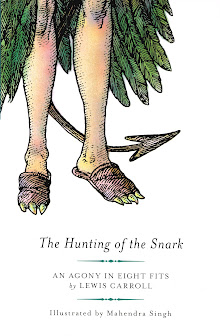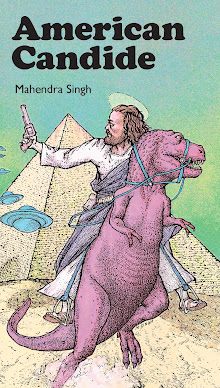
THE HUNTING OF THE SNARK by Lewis Carroll, a graphic novel by this artist and explained here, page by page, panel by panel … right now we're in Fit the Sixth, where the Barrister (played by Martin Heidegger) is dreaming of prosecuting a pig …
When drawing a dream in which the dreamer not only plays the part of every character in his dream, but is himself being played by the Eminent Continental Steamer, Martin Heidegger, the prudent illustrator pauses for thought.
From whence comes this illustrator's antipathy for Marty Heidegger? Is it the blathery philosophical drivel? The penchant for racist careerism? The beady, piggy eyes?
Perhaps the above stanzel can furnish some answers, for it is intimately concerned with "finding a verdict", ie., a quest for the truth, forensic and otherwise. The truth in this case is GUILTY, a blanket existential statement which Marty would have approved of, appealing as it does to the winsome young co-eds that Marty preferred to rummage through after classes.

But we Snark Hunters are made of sterner stuff. We take our philosophical marching orders from none other than Diogenes the Cynic (as shown here in Gerome's splendid painting), the bane of bloviating professors and politicians alike!
Diogenes was very much the Boojum of Western philosophy's Snark Hunt, preferring as he did to simplify things by cogitating in public while naked. He was a jolly rascal who often wandered through Athens with a lantern in daylight, claiming to be searching for an honest man. In case no one got the joke, he also preferred to live in a large barrel in which he would roll through the agora during moments of national crisis, a political tactic in need of revival in our troubled times.
His philosophy was simple, literally, and this simplification has earned him the eternal disdain of more practical-minded people, the kind of people who prefer the more comforting truths of money, religion, consumerism and groupthink.
In our Snark Hunt, we've replaced his barrel with the Bellman's Bell and we've clothed him in the garb of an English Barrister so as not to frighten the kiddies, but I think you get the general idea.
The truth, dear readers, is the very last thing one wishes to entrust to Barristers or Philosophers, unless, of course, they are furnished with a lantern, smelling of raw onions (oh yes, I've included them) and blessed with a dog-like sense of fidelity to the tenets of Cynicism.
Of course, we're all guilty of something or the other in this Snark Hunt, alas.
But you can buy a copy of this graphic novel and thus expunge some of your guilt in enjoying this free Carrollian exegesis whilst I shiver in my barrel-like garret. I shall expunge my own guilt by emulating Diogenes and doing some naked inking whilst my faithful King Charles Cavalier Spaniel lies at my feet, dreaming of chasing the squirrelly Boojums which plague her sleep.











